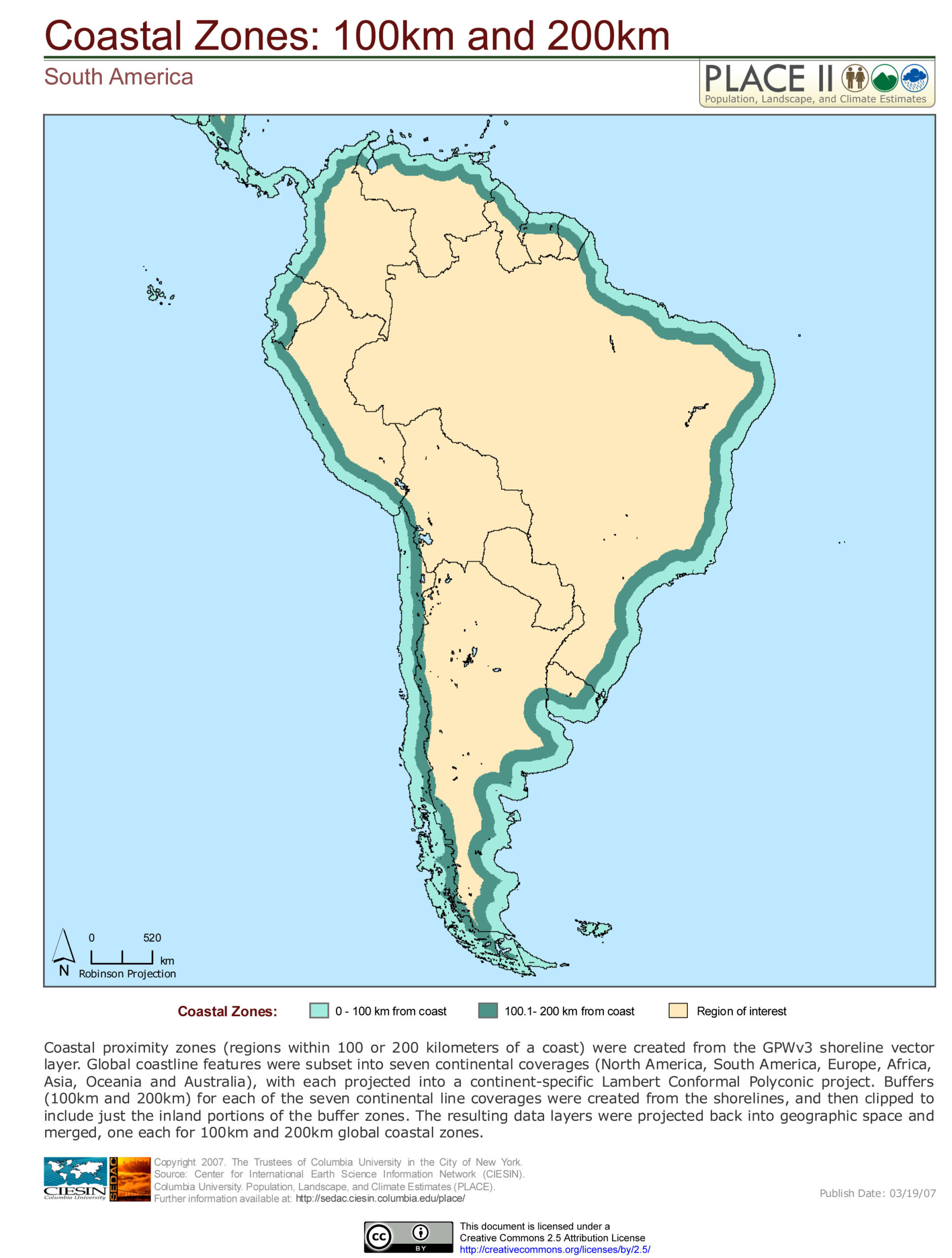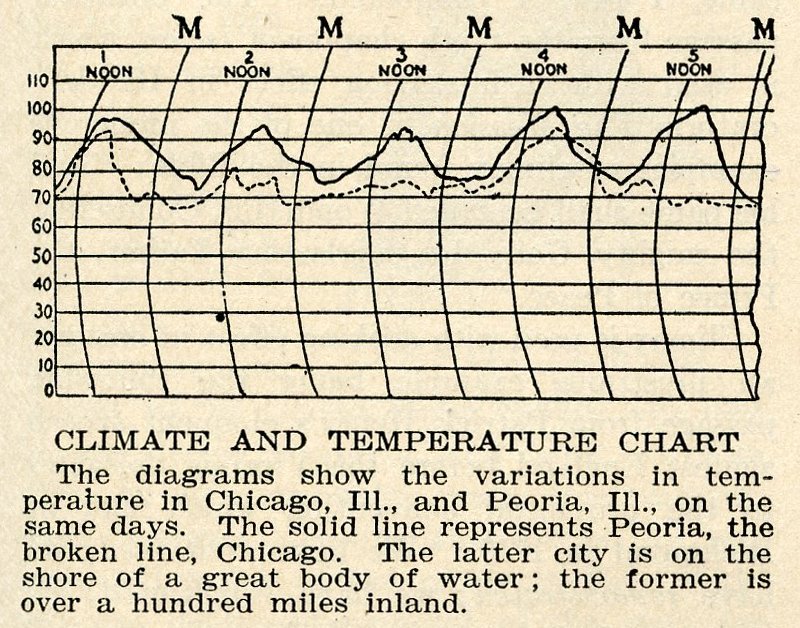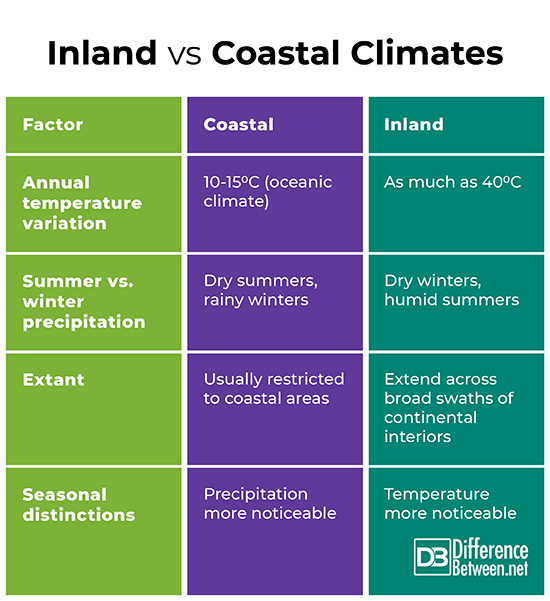Difference Between Coastal and Inland Climates

What are Coastal Climates?
Coastal climates are climates that characterize the edges of continental landmasses adjacent to the ocean. These regions tend to have relatively mild summers and winters and small differences in temperature between the seasons. Two common types of coastal climates are Mediterranean climates and marine west coast climates, or oceanic climates.
What is Mediterranean Climate?
Mediterranean climates occur in coastal areas usually between 30 and 45 degrees in the northern and southern hemispheres. In the current geological epoch, Mediterranean climates usually occur on the western edges of continents. The Mediterranean climate is named for the Mediterranean Sea.
Mediterranean climates have hot, dry summers, and cool, wet winters. Precipitation in Mediterranean climates varies between 35 cm and 90 cm per year. The lowest rates of precipitation occur in areas adjacent to desert, steppe, and other dry climates.
Mediterranean climates are affected by subtropical airmasses. During the summer, the subtropical anticyclone will move poleward. This will result in subsiding air which will bring clear skies and warm temperatures. During the winter, the subtropical anticyclone will move back towards the equator, resulting in frontal cyclones which will bring the rainy season. Mediterranean climates are usually confined to the coast and will grade into more continental or arid climates further inland. During the summer, some Mediterranean areas will also host fogbanks and cooler temperatures directly along the coasts. Examples of regions with a Mediterranean climate, or regions which include areas with a Mediterranean climate regime, include southern California, Israel, Greece, and Spain.
Marine west coast climate
The marine west coast climate, or oceanic climate, is a climate prevalent along the coasts of major continents and landmasses, occurring between 35° and 60° latitude both north and south. Oceanic climates are characterized by mild winters and mild summers. Temperature differences tend to be small, only about 10-15 ℃. This climate type occurs far enough from the equator to be beyond the influence of the subtropical anticyclone, but being nearby the ocean, which regulates temperature, makes it milder than climes that are further inland. These climates are known for having relatively high levels of precipitation, as much as 50-250 cm per year and more than 150 days of rain each year. The rain, however, is often low intensity. Fog is also common during the autumn and winter months. During the summer, temperatures usually do not exceed about 20 ℃. This climate type is prevalent in the coastal regions of western North America, New Zealand, and parts of western Europe. In North America, north-south mountain ranges cause this climate to be restricted to narrow strips along the coast. In Europe, however, this climate extends about 2000 km inland to eastern Germany and Poland.

What are Inland climates?
Inland climates, or continental climates, characterize the interiors of large continents such as North America and Asia. They are characterized by cold winters and hot summers and large temperature variations throughout the year. The reason for the larger temperature variation in inland areas is because rock and soil have a lower heat capacity than water. As a result, land areas both lose and gain heat much faster than maritime areas. Two broad classes of continental climates are humid continental climates and subarctic continental climates.
Humid continental climate
Humid continental climates occur between 30° to 60° latitude mostly in central and northeastern North America and Asia. They are characterized by hot, humid summers and cold, dry winters. The interplay between cold polar airmasses and warm tropical airmasses makes weather highly variable in these climates. Rainfall is relatively abundant with 50 to 125 cm of rainfall per year. It mainly comes from frontal cyclones and, in the case of summer, from convectional showers due to the intrusion of tropical air. During the early summer, there are often tornadoes and severe thunderstorms. During the winter, precipitation comes in the form of snow. These climates typically host continuous snow cover 1-4 months out of the year.
The winter is generally cold, but the interaction between polar and tropical air creates cold spells and warm spells throughout the winter. Humid continental climates typically have 150-200 frost-free days out of the year. Average temperatures below freezing typically last one to several months each year.
Regions with this type of climate include western Russia, parts of eastern Europe, and much of the central northern United States, such as Wisconsin and eastern North Dakota.
Subarctic continental climate
Subarctic continental climates occur at latitudes of 50° to 70° in the northern hemisphere. They typically experience bitterly cold dry winters and mild, relatively wet summers. The winters consist of short, clear days where temperatures can get as low as -50 ℃. Temperatures can be below freezing for 6 to 8 months out of the year and there are typically only 50-90 frost free days annually.
The summers are mild with long days and temperatures of no more than 25 ℃ at the highest, on average. Typically, there is less than 50 cm of precipitation per year, with most of it concentrated in the summer months. In the most inland regions with subarctic continental climates, the temperature range between summer and winter is as much as 60 ℃. This climate type has the largest temperature range of any other climate regime on Earth. Regions with this climate regime include Alaska, Siberia, northern Scandinavia, and northern Canada.
Similarities between coastal and inland climates
Inland and coastal climates are both influenced by the affects of polar airmasses, tropical airmasses, or both. Both climate types also experience relatively high levels of precipitation, except for Mediterranean climates and subarctic continental climates which are relatively arid.
Differences between Coastal and Inland Climates
Although there are similarities between these two types of climates, there are also important differences. These include the following.
- Coastal climates have low variations in temperature. For example the temperature variation in oceanic climates is 10-15 ℃, whereas inland climates have temperature variations of as much as 40 ℃.
- Coastal climates tend to have wetter winters and drier summers, whereas inland climates have more humid summers and drier winters.
- Coastal climates are typically limited to narrow strips along the edges of continents, whereas inland climates tend to occur over broad swaths of continental interiors.
- In coastal climates, rainfall is more noticeable for distinguishing seasons, whereas, in inland climates, temperature is more noticeable.
Inland vs. coastal climates

Summary of Inland and Coastal Climates
Coastal climates are climates that occur along the edges of continents. They are characterized by mild winters and summers, where the summers tend to be hotter and drier and the winters tend to be colder and wetter. The temperature variation is typically moderate. Two common types of coastal climates are Mediterranean climates and marine west coast climates. Inland climates are climates that usually occur in continental interiors. They are characterized by hot summers and very cold winters. There tend to have large variations in temperature between summer and winter, as much as 40 ℃. The winters tend to be long and dry. The summers tend to be short and relatively wet. Coastal climates and inland climates are both affected by polar airmasses, tropical airmasses, or both in some cases. They also receive an ample amount of precipitation, except for the most arid types. They also differ in important ways. Coastal climates have relatively dry summers and wet winters and are restricted to coastal areas. Inland climates, on the other hand, have dry winters and more humid summers, cover very large areas in continental interiors, and are more distinguished by temperature. Also, seasonal differences are more noticeable in the differences in precipitation in coastal climates, whereas the temperature differences between seasons are more notable in inland continental climates.
- Difference Between Environmental Performance Index and Development - November 24, 2023
- Difference Between Environmental Intervention and Development - November 8, 2023
- Difference Between Eco Efficiency and Eco Effectiveness - September 18, 2023
Search DifferenceBetween.net :
Leave a Response
References :
[0]Arnfield, A. John. “Koppen climate classification.” Encyclopaedia Britannica, Encyclopaedia Britannica, inc., 30 Jan. 2020, https://www.britannica.com/science/Koppen-climate-classification/World-distribution-of-major-climatic-types#ref1092513, accessed 28 Sep. 2020.
[1]Bowman, John S., Richard Ralph Mowbray Clogg, and John Frederick Haldon et al. “Greece – Climate.” Encyclopaedia Britannica, Encyclopaedia Britannica, inc., 30 Sep. 2020,https://www.britannica.com/place/Greece/Climate, accessed 30 Sep. 2020.
[2]“Monthly weather forecast and climate North Dakota, USA.” Weather Atlas, N.D, https://www.weather-us.com/en/north-dakota-usa-climate#:~:text=North%20Dakota%20has%20a%20humid,hot%2C%20while%20winters%20are%20cold.
[3]Viguera, Maria J., Raymond Carr, and Catherine Delano Smith et al. “Spain – Climate.” Encyclopaedia Britannica, Encyclopaedia Britannica, inc., 27 Sep. 2020, https://www.britannica.com/place/Spain/Climate, accessed 30 Sep. 2020.
[4]Image credit: https://farm6.staticflickr.com/5092/5486110352_d208d7144d_o.jpg
[5]Image credit: https://live.staticflickr.com/6210/6145615060_67e0577d5b_c.jpg
